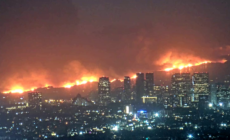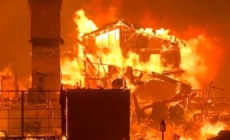-
Charges Filed in the Case of Extremist Attacks in Budapest - 28 seconds ago
-
Shape-shifting AI Transformer homes will leave you wanting one - 5 mins ago
-
Column: After years of helping the homeless, he’s one of them after Altadena fire destroys his house - 13 mins ago
-
MrBeast Offers To Buy TikTok To Stop Ban - 16 mins ago
-
A.J. Brown spotted reading ‘Inner Excellence’ during Eagles-Packers | First Things First - 19 mins ago
-
The Hungarian Community has Shown Unity Amid the Los Angeles Fires - 37 mins ago
-
1/13: CBS Evening News – CBS News - 50 mins ago
-
US allies’ undersea cables are cut, world looks to Russia and China - 51 mins ago
-
Russian TV Says ‘We Need Greenland,’ Eyes Deal With Trump - 58 mins ago
-
Vikings vs. Rams highlights: LA swarms Sam Darnold in 27-9 win - about 1 hour ago
Altadena Resident Reveals Chaotic Eaton Fire Evacuation: ‘Too Late’
Amid the Los Angeles wildfires, an Altadena resident who lost her family home and her grandmother’s home in the Eaton fire revealed the chaotic evacuation that took place in the area when the fires broke out.
Speaking with Newsweek via phone, 23-year-old Altadena native Briana Johnson explained that the evacuation was not carried out in a way that anyone would expect for something as significant as a life-threatening fire.
Due to a combination of a lack of power making it difficult for people to catch up on the news, a police force that was spread too thin, and inexplicably slow evacuation orders, Johnson explained how many residents found themselves fleeing for their lives at the very last minute and are now left with no possessions at all.
Newsweek has reached out to California Governor Gavin Newsom’s office via email for comment.
So far, the Eaton fire, which is burning across 14,117 acres, has destroyed 1,422 structures, and is still only at 27 percent containment, according to the California Department of Forestry and Fire Protection (CAL Fire).
“When you picture evacuating people for a fire, you picture police officers coming up and down the street, knocking on doors, being like, ‘Hey, are you guys okay, trying to evacuate?’ That’s not what happened,” Johnson told Newsweek. “Nobody had any idea what was going on. There was a police officer who drove down the street, and they were kind of like, ‘oh, evacuate.’ But it wasn’t loud at all. If I was inside of the house, I would not have heard that.”
Evacuation orders were sent out by the Los Angeles County government and emergency communications company Genasys, and evacuation zones are updated by CAL Fire. Maps can also be found via WatchDuty, an app which periodically updates evacuation zones and open source gathered updates.
Johnson explained that a lot of her friends had to wake up their family members to get them to leave.
“Half the city didn’t have power, and so a lot of people, if you weren’t watching the news and you were just going to bed, you wouldn’t have known anything was wrong until it was like, two or three in the morning,” she said. “And by that point, it was too late to be packing a bag and genuinely thinking about, ‘We’re gonna leave the house.'”
Briana Johnson
Johnson explained that the alert to her area in Altadena did not go out until 3 a.m., despite the fire starting around 6:30 p.m. earlier that night.
“If they had sent out an alert earlier, I feel like a lot more people would have been ready,” she said.
Johnson was aware of the fires from the news, but the spread of them became clear to her when her dad, who was driving home from work, called to say he could see the fire and they should get prepared to leave as soon as possible.
Despite evacuating two to three miles away from the initial evacuation zone to her grandmother’s house, which was also in Altadena, the fire quickly caught up to them.
This is when Johnson personally experienced the lag in Los Angeles’ evacuation notices. She initially felt safe at her grandmother’s as she was frequently checking the evacuation map that said the wind was not blowing towards them, but this was not actually the case outside.
“There was about a three-hour gap in between when we evacuated our house and when the map updated. We were already in the evacuation zone, and probably had been for like an hour or two…[The map] was just not updating and there was no alert until the fire. I literally looked out the window and I could see the mountain on fire,” the 23-year-old explained.

Briana Johnson
A lag in communication is not the only issue experienced by Angelenos desperate for information. Last week, emergency evacuation orders were accidently sent to nearly 10 million Los Angeles residents.
Los Angeles county’s emergency management office said in a statement to The New York Times that it sent an “accurate, correctly-targeted alert” on Thursday, but it accidently went beyond its intended audience. After the initial error, “echoes” of that alert—carrying an identical warning message—popped up on cellphones throughout Friday, the newspaper reported.
Lauren Ames, a spokeswoman for Genasys, told the Times on Friday that the company was working with the county to “identify the cause” of the problem.
“It was horrible, for those 20 minutes, as I was gathering my life together,” Brittney Mendez who lives in Reseda told the Times.
X, formerly Twitter, user David Hermann wrote on Friday: “Two times in the last 15 hrs LA County has sent out evacuation warning notifications to all of Los Angeles. This is bad…What is going on?”
Newsweek has contacted Genasys via online form and LA County via email for comment.
President-elect Donald Trump has placed blame for the wildfires on Newsom, saying they are “all his fault” and that he should resign.
“Governor Gavin Newscum should immediately go to Northern California and open up the water main, and let the water flow into his dry, starving, burning State, instead of having it go out into the Pacific Ocean,” Trump wrote on Truth Social. “It ought to be done right now, NO MORE EXCUSES FROM THIS INCOMPETENT GOVERNOR. IT’S ALREADY FAR TOO LATE!”
Trump has claimed Newsom refused to sign a “water restoration declaration” that would have allowed millions of gallons of water from excess rain and snow to flow into California. Newsom and other officials have stated that no such declaration exists. Most water used in Los Angeles doesn’t come from Northern California but from local aqueducts and groundwater.
Izzy Gardon, Newsom’s director of communications, previously told Newsweek: “There is no such document as the water restoration declaration, that is pure fiction. The Governor is focused on protecting people, not playing politics, and making sure firefighters have all the resources they need.”
Newsom has said he’s “not interested in politicizing a natural disaster,” and invited Trump to visit the area. Trump, so far, has yet to respond.
Johnson, meanwhile, joked that when her parents remarked on how good she was at packing for the evacuation she pointed out that she already had to evacuate her college dorm during the COVID pandemic, so she’s had plenty of practice.
Johnson was on track to take the MCAT in March, but said she will probably have to push that back now, not only because she does not know where she will be living in March, but also because her testing center was going to be in Pasadena, and she doesn’t know if that center is still standing as of right now.
Johnson hopes that these fires are a wakeup call to people who still think climate change is not already affecting millions of people.
“There’s no reason that it shouldn’t rain in December, even in Southern California,” she said. “As a child, it used to rain during December. The Eaton Canyon reservoir used to be full of water, so much so that the trees looked like bushes. It has never been 70 degrees in December in Southern California, we’ve had windstorms in the past that were terrible, but it had rained, so it wasn’t a problem.”
Speaking about her community, a historically Black middle-class part of Los Angeles, Johnson said: “It’s heartbreaking to see so many of these multi-generational Black and brown families losing their entire safety, losing everything they’ve worked for. And a lot are paid homes that aren’t on a mortgage, so they’re houses that people own and have owned for 50 plus years.”
Despite all of her loss, Johnson has a positive outlook about the future of her community.
“I definitely want to stay,” Johnson said about Altadena. “I’m really excited for the future and rebuilding, and I hope that people hold on to their land and their properties and don’t sell, because I think there’s potential for it to grow into something even more beautiful.”
Johnson added that before the wildfires she saw a lot of people selling their houses, and apartment blocks being built where houses used to be, but the fires have brought a shift in perspective to locals.
“People are realizing how much they really love the city, and I think it’s possible for us to rebuild,” she said. “I’ve seen so much love and generosity pouring out of the neighborhood. It’s really beautiful.”
Source link































